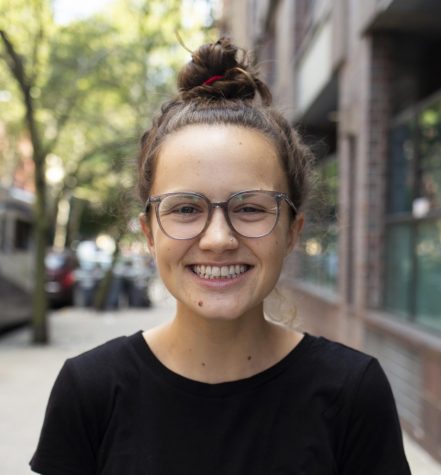AIDS Crisis Should Be More Culturally Emphasized
September 25, 2017
At the beginning of my freshman year, my friend and I went for a run and wound up at the World Trade Center. We walked through the memorial, stopping to look at one of the sunken waterfalls. One of the security guards came up to us and asked us to leave, looking disdainfully at our running shoes and sweaty t-shirts. “No sports allowed here,” he told us. “I need you to leave.”
That December, the official New York City AIDS Memorial opened on a small street intersection on W. 12th St. and Greenwich Ave. When I looked it up on Google Maps, it took me to the wrong place. The memorial itself is beautiful — a towering triangular structure, the ground engraved with an excerpt of Walt Whitman’s “Song of Myself,” a serene waterfall flowing in its center. The location was chosen because it is where St. Vincent’s hospital used to stand, the first hospital in New York City to open a specific AIDS ward. It’s small but lovely, and one of my favorite places to write. The design was chosen through a contest and pays a beautiful homage to those lost in the tragedy over the years. Others don’t seem to notice it, though — hoards of tourists pass it by without stopping for a photo. No security guards stand by, and parents let their children play in the fountain.
On 9/11, 2,606 people died in New York City. To date, more than 100,000 New Yorkers have died of AIDS. The memorial holds no names, because their tragedies were hidden as cultural blasphemy. While both 9/11 and the AIDS epidemic resulted in tragic losses of young people, AIDS targeted the gay community.
This stark contrast is a more serious reflection of our society’s morphed views of 9/11 and the AIDS epidemic as a whole. On Sept. 11 this year, my social media was filled with the #neverforget hashtag and photos of the towers, often with a patriotic U.S. flag edited in on the side. I understand and respect the fact that 9/11 was a massive moment for our nation, yet America’s intense, one-sided perspective of the event isn’t necessarily healthy. The fear that we will ever forget the terrorist attacks is unwarranted, as the event so deeply shifted both American and global culture that it would be almost impossible to let it go.
The AIDS epidemic, however, still remains a neglected topic of discussion in our society, massively because of the demographic of those who passed away. At the time of the initial epidemic, people diagnosed with HIV/AIDS struggled immensely to get pharmaceutical companies to run tests on potentially life-saving drugs, and the infected population was considered too small for there to be an economic benefit to producing a drug. AIDS hit the U.S. and New York, specifically, harder than it did any other developed nation. It turned many against the LGBT community, and people cited the epidemic as something deserved, something brought down by God to punish their lifestyles. Parents didn’t explain to their children what was going on while victims died by the hour for years on end. Little changed until the LGBT community stood up on its own and fought for its rights, yet there were still few supporters from the outside. The stark difference between the two New York City memorials is a small testament to the continual ignorance and isolation of the LGBT community in our society today.
As the LGBT community continues to struggle with different issues today, from marriage to transgender rights, it is still important that the LGBT community receives alliance and recognition from the rest of our nation. The community is not one to be feared, it is one that intertwines through race, gender and culture across every neighborhood in America. The AIDS epidemic affected the friends and families of millions of Americans — just as 9/11 did. In order to move forward, we need to let go of the marginalization of LGBT members and recognize them as equal members of our society. The AIDS epidemic needs to be taught in schools, embedded thickly and accurately into our society for what it was — a tragedy. Tragedy can’t be quantified, but it can be ignored, and we cannot keep acting as if one matters more than another.
Opinions expressed on the editorial pages are not necessarily those of WSN, and our publication of opinions is not an endorsement of them. Email Laura Shkouratoff at [email protected]. A version of this appeared in the Monday, Sept. 25 print edition.




























































































































































